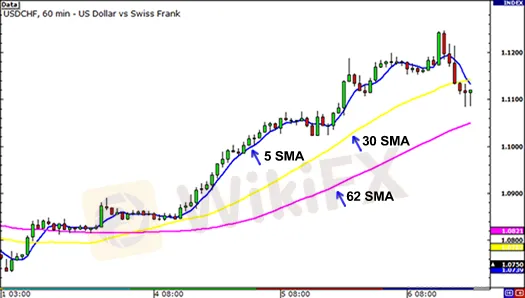简体中文
繁體中文
English
Pусский
日本語
ภาษาไทย
Tiếng Việt
Bahasa Indonesia
Español
हिन्दी
Filippiiniläinen
Français
Deutsch
Português
Türkçe
한국어
العربية
SMA (Simple Moving Average) Explanation
Abstract:The simplest type of moving average is the simple moving average (SMA). A simple moving average is calculated by summing the closing prices of the previous "X" period and then dividing that amount by X.
The simplest type of moving average is the simple moving average (SMA).
A simple moving average is calculated by summing the closing prices of the previous “X” period and then dividing that amount by X.
Using the Simple Moving Average to Calculate (SMA)
If you wanted to plot a 5-period simple moving average on a 1-hour chart, sum together the closing prices for the previous 5 hours and divide by 5.
Voila! You've got the average closing price for the previous five hours! When you add all of those average prices together, you get a moving average!
If you wanted to plot a 5-period simple moving average on a 30-minute chart, add together the closing prices from the previous 150 minutes and divide by 5.
If you plot the 5-period simple moving average on the 4-hour chart, you'll see... Yes, okay, we understand. You see what I mean?
The majority of charting software will perform all of the calculations for you.
We just boring you (yawn!) with a “how to” on computing simple moving averages since it's crucial to learn so you can adjust and tweak the indicator.
You can alter and build different tactics as the market environment evolves if you understand how an indicator works.
Moving averages, like practically every other forex indicator, work with a time delay.
You're simply seeing the overall course of recent price activity and the general direction of “future” short-term price action because you're using averages of prior price history.
Moving averages will not transform you into Ms. Cleo the clairvoyant!
Here's an illustration of how moving averages smooth out price movement.

On the 1-hour chart of USD/CHF shown above, we've plotted three different SMAs. As you can see, the greater the SMA time, the further behind the price it is.
The 62 SMA is further away from the current price than the 30 and 5 SMAs, as you can see.
This is because the 62 SMA divides the sum of the closing prices of the previous 62 periods by 62.
The longer the time for the SMA, the slower it reacts to price fluctuation.
The SMAs in this chart depict the market's overall attitude at this moment in time. We can see that the pair is trending on this graph.
Instead of focusing solely on the present market price, moving averages provide a broader perspective, allowing us to forecast the market's future price direction.
We can tell whether a pair is trending up, going down, or merely range using SMAs.
The simple moving average has one drawback: it is sensitive to spikes.
When this occurs, we may receive false indications. We may believe that a new currency trend is forming, but nothing has changed in fact.
We'll explain you what we mean in the following course, as well as introduce you to another sort of moving average that will help you avoid this issue.
Disclaimer:
The views in this article only represent the author's personal views, and do not constitute investment advice on this platform. This platform does not guarantee the accuracy, completeness and timeliness of the information in the article, and will not be liable for any loss caused by the use of or reliance on the information in the article.
Read more

Forex is a game that I enjoy playing
These champions have one thing in common: they not only work their butts off, but they also enjoy what they do.

Wait patiently. Maintain your discipline
"Patience is the key to everything," American comic Arnold H. Glasgow once quipped. The chicken is gotten by hatching the egg rather than crushing it."

There isn't a Holy Grail to be found!
Ask any Wall Street quant (the highly nerdy math and physics PhDs who build complicated algorithmic trading techniques) why there isn't a "holy grail" indicator, approach, or system that generates revenues on a regular basis.

Concentrate on the Process. Profits aren't a priority
We've designed the School of WikiFX as simple and enjoyable as possible to help you learn and comprehend the fundamental tools and best practices used by forex traders all over the world, but keep in mind that a tool or strategy is only as good as the person who uses it.
WikiFX Broker
Latest News
What is a Stop Out Level?
Challenges of A-Book Execution
Japanese Candlestick Anatomy
What is the difference between support and resistance?
Candlesticks with Support and Resistance
Dual Candlestick Patterns
Basic Japanese Candlestick Patterns
How to Place Your Stop Using Fibonacci to Lose Less Money
What is the Difference Between Double Tops and Double Bottoms?
Bearish and Bullish Pennants and How to Trade Them
Currency Calculator


